This document provides guidance on implementing comprehensive HIV/STI programmes with sex workers. It discusses the importance of community empowerment, addressing violence against sex workers, and establishing community-led services such as outreach, drop-in centers, and quality improvement initiatives. The document emphasizes working with sex worker communities and fostering sex worker leadership to develop effective and sustainable programmes. It also provides practical guidance and examples of interventions to integrate sex worker-led approaches into HIV/STI programming.







































![1Community Empowerment
1.4 Resources and further reading
1. UNAIDS guidance note on HIV and sex work. Geneva: Joint United Nations Programme on HIV/AIDS, 2012.
http://www.unaids.org/en/media/unaids/contentassets/documents/unaidspublication/2009/JC2306_UNAIDS-
guidance-note-HIV-sex-work_en.pdf
2. Prevention and treatment of HIV and other sexually transmitted infections for sex workers in low- and middle-
income countries: recommendations for a public health approach. Geneva: WHO, UNFPA, UNAIDS, NSWP,
2012.
http://apps.who.int/iris/bitstream/10665/77745/1/9789241504744_eng.pdf
3. The Global HIV Epidemics among Sex Workers. Washington, DC: World Bank, 2013.
http://www.worldbank.org/content/dam/Worldbank/document/GlobalHIVEpidemicsAmongSexWorkers.pdf
4. SANGRAM’s Collectives: Engaging Communities in India to Demand their Rights. Arlington, VA: AIDSTAR-
One/John Snow, Inc., 2011.
http://www.aidstar-one.com/sites/default/files/AIDSTAR-One_CaseStudy_GenderMARPs_SANGRAM_India.
pdf
5. Recommendation concerning HIV and AIDS and the World of Work, 2010 (No. 200). Geneva: International
Labour Organization, 2010.
http://www.ilo.org/aids/WCMS_142706/lang--en/index.htm
6. Sex Work and the Law in Asia and the Pacific: Laws, HIV and human rights in the context of sex work.
Bangkok: United Nations Development Programme Asia-Pacific Regional Centre, 2012.
http://www.undp.org/content/dam/undp/library/hivaids/English/HIV-2012-SexWorkAndLaw.pdf
7. Community Mobilization of Female Sex Workers: Module 2, A Strategic Approach to Empower Female Sex
Workers in Karnataka. Bangalore, India: Karnataka Health Promotion Trust, 2008.
http://www.khpt.org/Community_Mobilization.pdf
8. Scamell D. Legal help for sex workers—from sex workers. Open Society Foundations, March 5, 2013.
http://www.opensocietyfoundations.org/voices/legal-help-sex-workers-sex-workers
9. HIV and the Law: Rights, Risk and Health. New York, NY: Global Commission on HIV and the Law, United
Nations Development Programme, 2012.
http://www.hivlawcommission.org/index.php/report
10. The HIV and Sex Work Collection: Innovative responses in Asia and the Pacific. Bangkok: United Nations
Population Fund, Joint United Nations Programme on HIV/AIDS and Asia Pacific Network of Sex Workers [no
date].
http://www.unaids.org/en/media/unaids/contentassets/documents/document/2012/20121212_HIV_SW.pdf
11. Building Partnerships on HIV and Sex Work: Report and Recommendations from the First Asia and the Pacific
Regional Consultation on HIV and Sex Work. Bangkok: Asia Pacific Network of Sex Workers, United Nations
Population Fund, Joint United Nations Programme on HIV/AIDS, 2011.
http://asiapacific.unfpa.org/public/pid/7491
12. The Global Network of Sex Work Projects (NSWP).
www.nswp.org
13. Bar Hostess Empowerment and Support Project (BHESP).
www.bhesp.org
14. Healthy Options Project Skopje (HOPS).
www.hops.org.mk/programs.htm
15. The Yogakarta Principles on the Application of International Human Rights Law in relation to Sexual
Orientation and Gender Identity (2007).
http://www.yogyakartaprinciples.org/
16. The Denver Principles (1983).
http://data.unaids.org/Pub/externaldocument/2007/gipa1983denverprinciples_en.pdf
18](https://image.slidesharecdn.com/9789241506182eng-140612092504-phpapp02/75/9789241506182-eng-40-2048.jpg)










![2Addressing Violence against Sex Workers
• working with journalists and other members of the media to promote positive stories and language
use about sex work
• building partnerships and networks with organizations that work on human rights and HIV, for joint
advocacy efforts (see Box 2.4)
• supporting collective action by sex workers to demand redress for violence faced by their
community members
• building programme managers’ understanding of laws affecting sex workers’ rights.
Case example: Building partnerships for advocacy in Karnataka, India
Addressingviolenceagainstsexworkersiscomplexandrequirespartnershipwithlike-mindedorganizations.
The Karnataka Health Promotion Trust (KHPT) has been working on HIV prevention among sex workers
in Karnataka, India for the last 10 years. Preventing and responding to violence emerged as a strong “felt
need” among sex workers.
KHPT sensitized and advocated with law enforcement (police) and judiciary not to perpetrate or condone
violence against sex workers. In partnership with KHPT:
• The state’s Women and Child Welfare Department made services for violence against women available
to sex workers as well.
• Community-based organizations worked with sex workers in 30 districts to sensitize them about their
rights.
• The Alternate Law Forum and the National Law School of India developed and conducted legal literacy
training for sex workers.
• The Centre for Advocacy and Research, an NGO, did media advocacy and trained sex workers as media
spokespersons to talk about the violence they face, their resilience and actions to prevent and respond
to violence.
Box 2.4
2.2.4 Fostering police accountability
Working with the police has been a key element of efforts to reduce violence against sex workers.
Activities may include:
• Sensitization workshops with the police that raise their awareness of laws related to sex work
and sex workers’ rights. These workshops also build relationships between sex workers and police
in order to minimize police harassment and violence. In some settings such workshops have been
led by sex workers (see Box 2.5); in other places they have involved lawyers (e.g. India); and in
some settings sex workers, police and NGOs have jointly conducted trainings (e.g. Keeping Alive
Societies’ Hope [KASH] in Kenya, and Tais Plus in Kyrgyzstan). Training topics that are covered in
various manuals (see Section 2.4) may include: basic introduction to HIV and HIV programming; laws
and law enforcement practices that affect sex worker rights, including those related to violence;
role of the police in HIV prevention; and human rights of sex workers.
• Advocacy (e.g. regular meetings with police as well as with high-level government officials
responsible for law enforcement) to reduce police harassment of sex workers and community
outreach workers (e.g. getting letters of support from the police that are carried by the outreach
workers), and to ensure the commitment of frontline officers to the trainings.
29](https://image.slidesharecdn.com/9789241506182eng-140612092504-phpapp02/75/9789241506182-eng-51-2048.jpg)





























![3Community-led Services
Case example: Opportunity gap analysis
In Karnataka, India, community outreach workers use a simple tool to analyse the specific barriers that
hinder individual sex workers’ access to programme services. Gaps in access are identified, whether due to
internal factors that the programme can control (e.g. the working times of community outreach workers) or
external factors (e.g. high mobility of sex workers resulting in dropouts from the programme). Site-specific
action plans are then developed to overcome these barriers.
Figure 3.8 shows an opportunity gap analysis by a community outreach worker responsible for 140 men who
have sex with men at a particular site. (Although these men are not necessarily sex workers, and although
the ratio of community outreach workers to men who have sex with men is very high due to the density of
the urban area in this example, the principle is the same.) The community outreach worker has assessed
his activity during the month by listing the number of men who have sex with men who are enrolled, the
number whom he regularly contacts, the number who have visited a clinic in last three months, and the
number who were tested for HIV in the last month. The community outreach worker then analyses with
his supervisor/manager those community members who were not reached by various services and the
reasons for this, and a plan is developed to address these gaps.
The opportunity gap analysis helps both the community outreach worker and the supervisor/manager to
assess whether the programme is reaching the community members with specific project services. The
exercise identifies areas where the community outreach worker needs to focus and areas where the
supervisor/manager needs to support the community outreach worker.
Box 3.6
Source: Karnataka Health Promotion Trust, Karnataka, India
Opportunity Gap Analysis
Zone: Supervisor:
Site: Community outreach worker:
Hotspot: Date:
Actual number Target Gap Reasons
Estimation 137 140 — —
Registration 137
100%
140
— —
Regular
contact
125
80%
120
(+5) —
Clinic visit 40
35% (monthly)
42
2 —
Syphilis 8
50% of target for
clinic visits
20
12
[Community outreach worker and
supervisor discuss and list reasons and
action plan here.]
Integrated
Counselling
and Testing
Centre (ICTC)
0
50% of target for
clinic visits
20
12
[Community outreach worker and
supervisor discuss and list reasons and
action plan here.]
Figure 3.8 Opportunity gap analysis
59](https://image.slidesharecdn.com/9789241506182eng-140612092504-phpapp02/75/9789241506182-eng-81-2048.jpg)























![4Condom and Lubricant Programming
condoms, providing condoms and lubricants in “safe spaces” (drop-in centres),9
through community
outreach workers and as part of health services. Sex worker organizations may also want to work
with managers and owners of sex work venues to involve them in condom distribution.
Sex workers should be engaged from start to finish in planning, mapping and implementing condom
and lubricant distribution points. Table 4.2 provides key questions that implementing organizations
should ask in planning for adequate supplies of condoms for sex workers.
Questions Potential answers
From what types of outlets do community
members prefer to obtain condoms?
(Place strategy)
• Sex worker “safe spaces” (drop-in centres)
• Community outreach workers
• Shops, pharmacies
• Medical clinics, doctors, hospitals
• Bars, guest houses, hotels, brothels
• Workplaces
• Truck stops, bus stops
What types of condoms do sex workers prefer?
(Price strategy)
• Free public-sector condoms
• Social marketing condoms
• Commercial condoms
• Others?
How close are condom outlets to the
community?
(Accessibility)
• Very close (1-5 minute [min.] walk)
• Close (10-20 min. walk)
• Far (30-45 min. walk)
• Very far (1 hour or more)
Do these outlets always have condoms to
provide?
(Availability)
Male condoms: Yes/No
Female condoms: Yes/No
Water- or silicone-based lubricants: Yes/No
How many condoms do sex workers and
clients have access to weekly?
(Current level)
Number of condoms per sex worker:
Male condoms:
Female condoms:
Lubricants:
How many do they need to access?
Unmet need (right quantity?)
Number of condoms required per sex worker monthly:
What are the most common problems sex
workers report with male condoms
(Right quality?)
• Breakage
• Slippage
• Condom has bad smell
• Condom is expired
• Condom package is damaged
• Other
What are the most common problems sex
workers experience with female condoms
(Right quality?)
• Condom has bad smell
• Condom is expired
• Condom package is damaged
• Other
Are condom-compatible lubricants always
available at condom distribution points?
Yes/No
Table 4.2 Condom supply planning questions
9 A safe space (drop-in centre) is a place where sex workers may gather to relax, meet other community members and hold social events, meetings or training.
See Chapter 3, Section 3.3 for details.
83](https://image.slidesharecdn.com/9789241506182eng-140612092504-phpapp02/75/9789241506182-eng-105-2048.jpg)
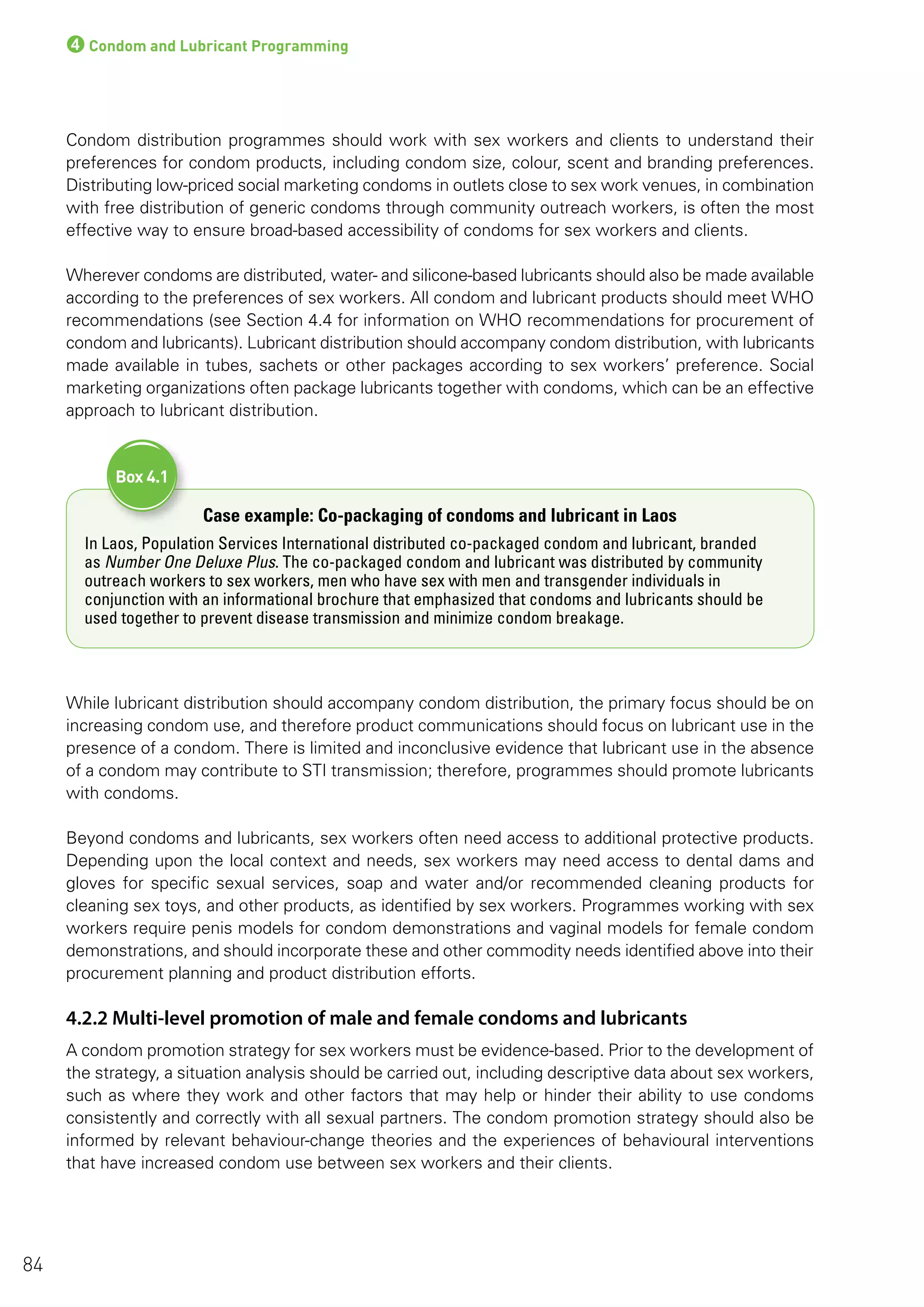


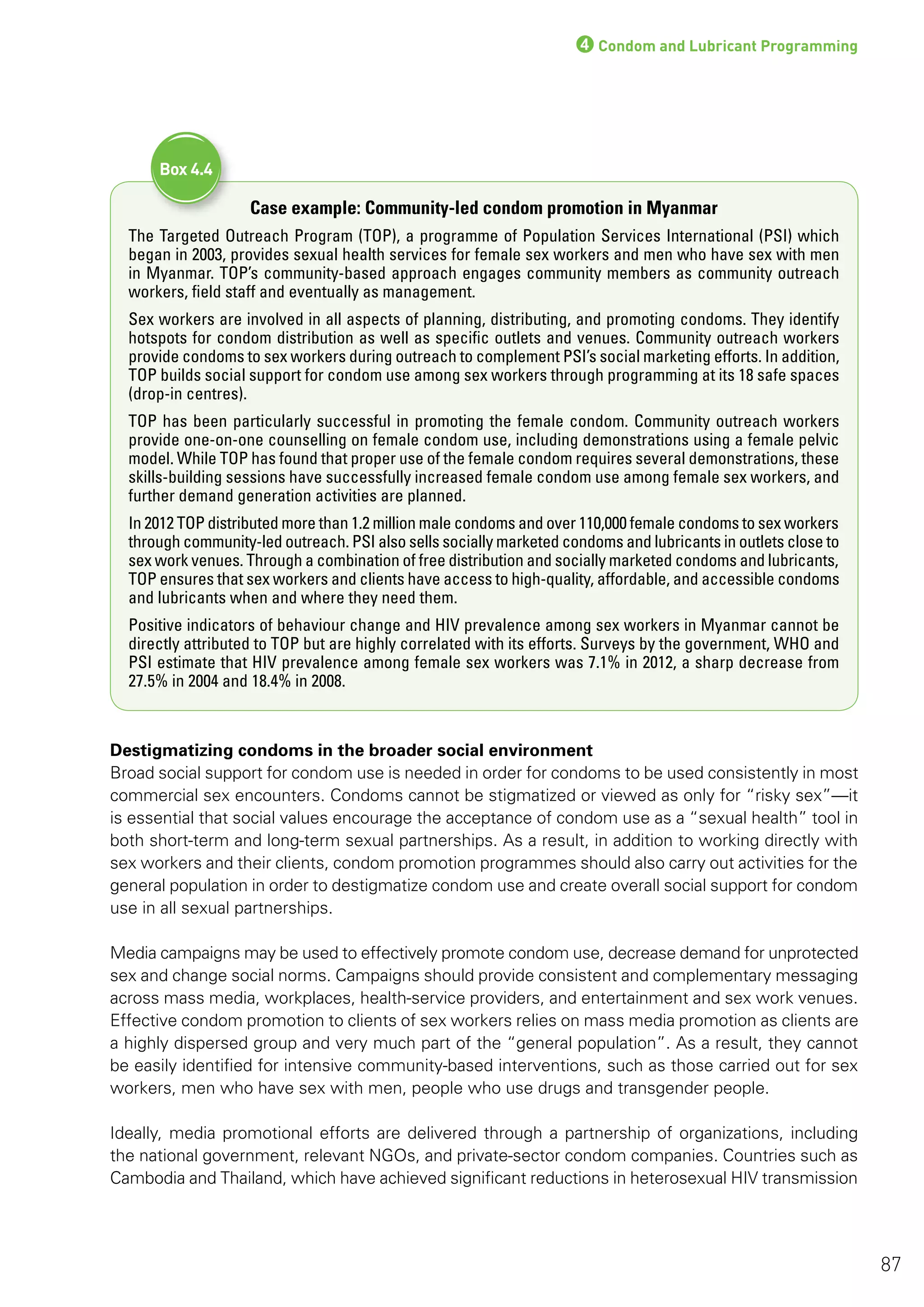





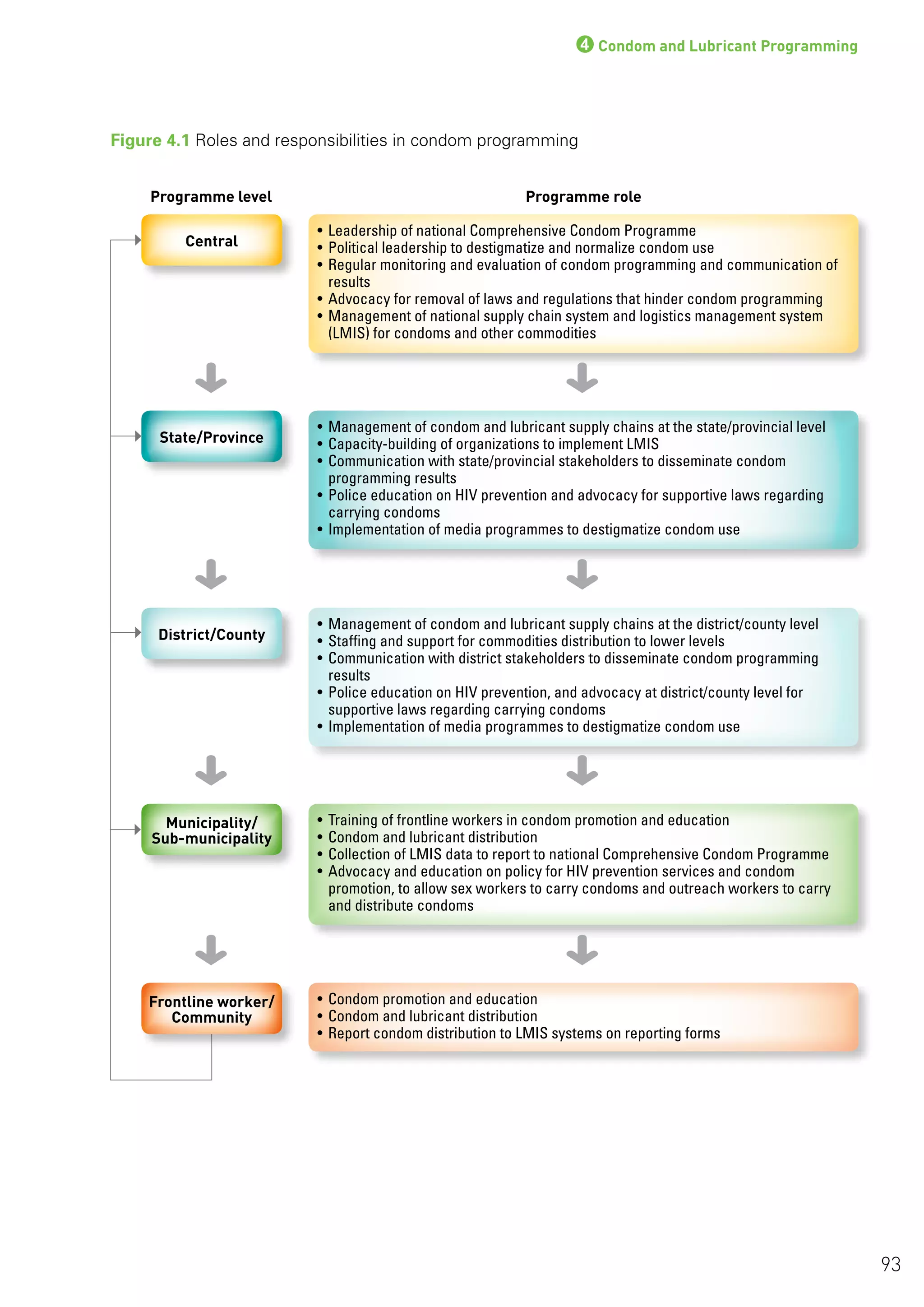

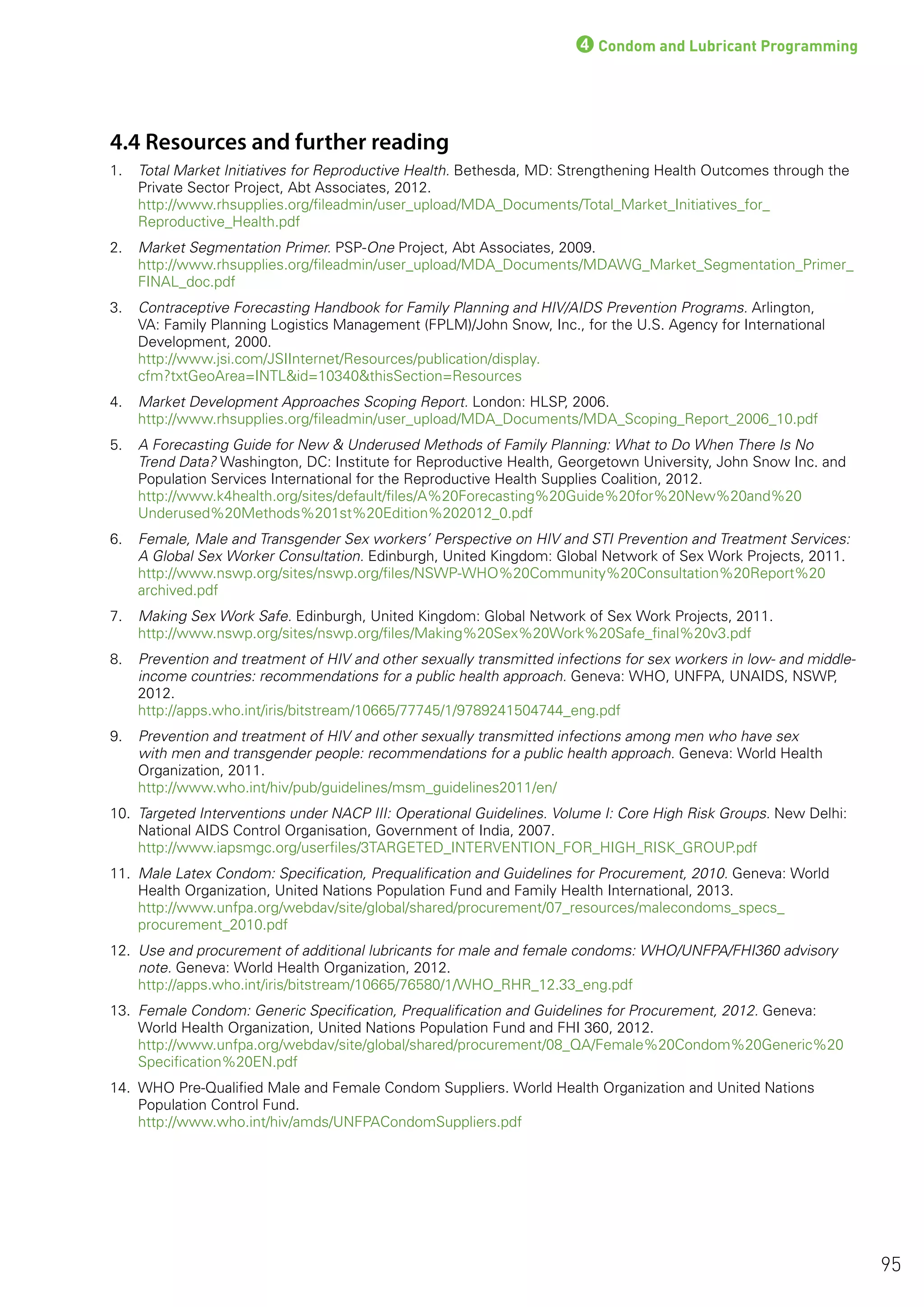





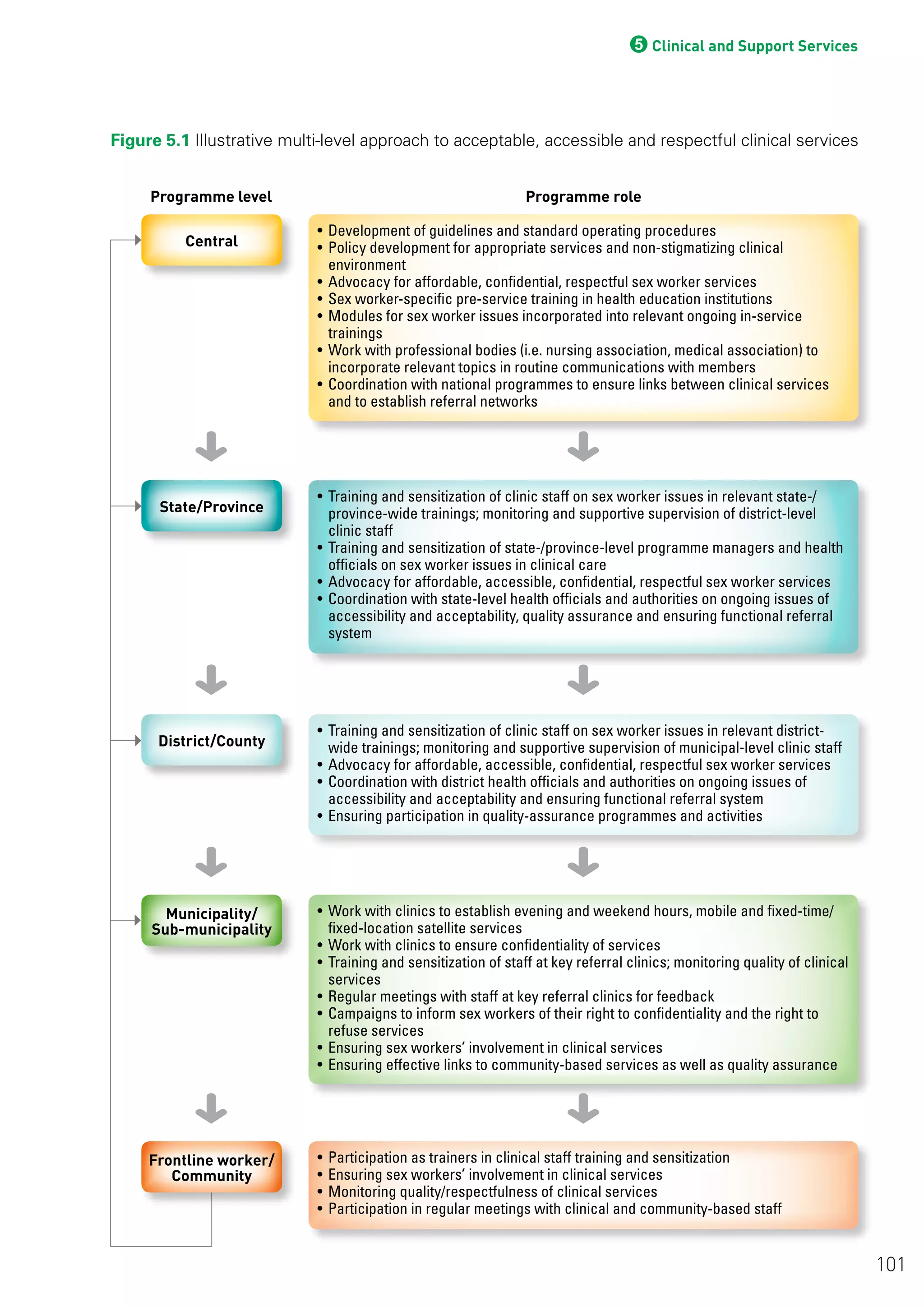


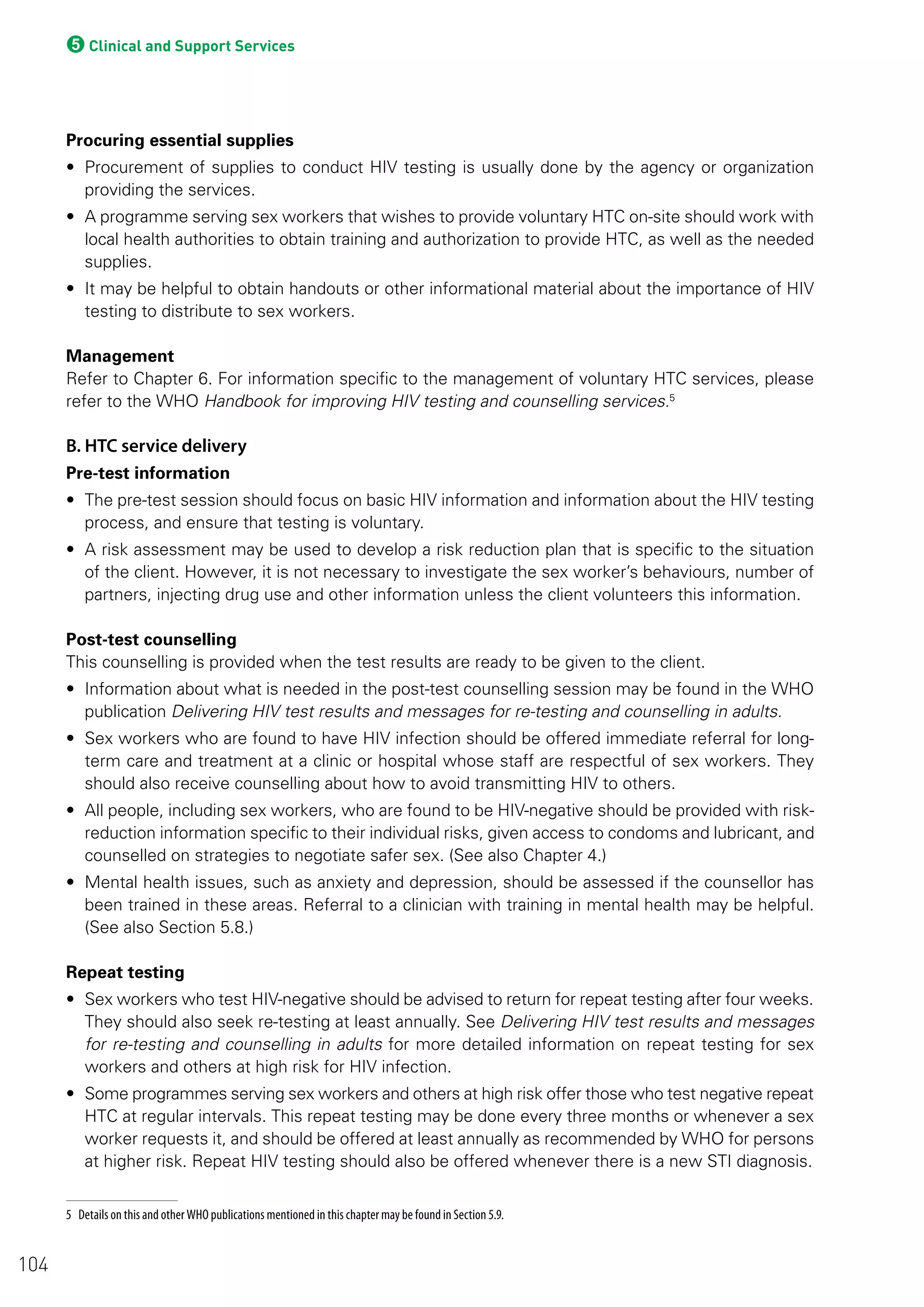
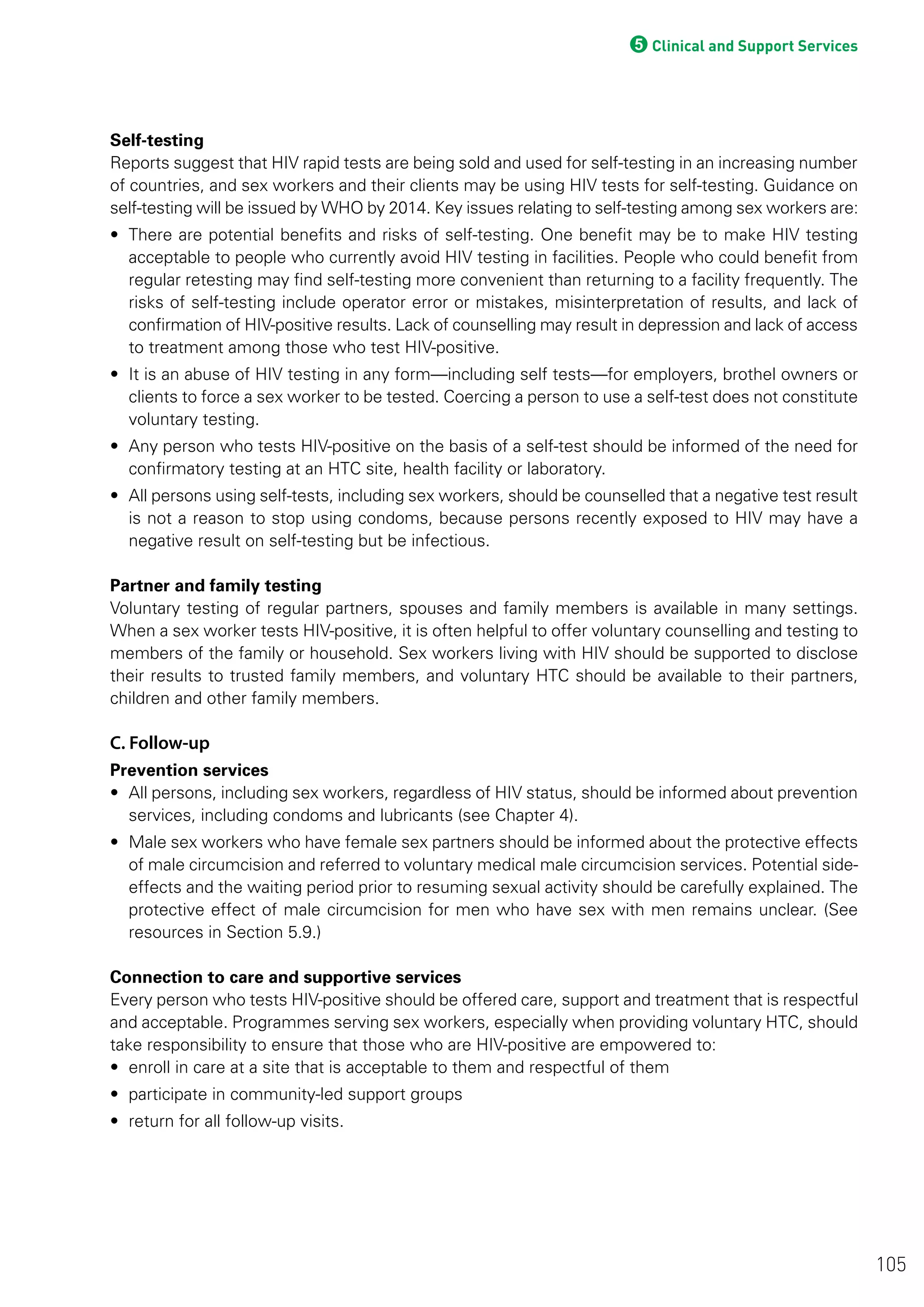


![5Clinical and Support Services
5.3.2 Essential definitions and prerequisites of ART services
The 2013 WHO Consolidated guidelines on the use of antiretroviral drugs for treating and preventing
HIV infections outline recommendations on when to start ART and what to use.
• ART should be initiated in all HIV-positive individuals with CD4 count ≤500 cells/mm3
regardless
of WHO clinical stage.
• As a priority, ART should be initiated in HIV-positive individuals with severe or advanced HIV clinical
disease (WHO clinical stage 3 or 4) and HIV-positive individuals with CD4 count ≤350 cells/mm3
.
• ART should be offered to all HIV-positive individuals, regardless of WHO clinical stage or CD4 cell
count, in the following situations:
›› individuals co-infected with HIV and active TB disease
›› individuals co-infected with HIV and hepatitis B virus (HBV) with evidence of severe chronic
liver disease
›› pregnant and breastfeeding women with HIV
›› HIV-positive partners in serodiscordant couples, to reduce the risk of HIV transmission to
uninfected partners
›› all HIV-positive children under 5 years old.
The guidelines also recommend:
• use of simplified, less toxic and more convenient antiretroviral regimens for first- and second-line
treatment, preferably as fixed-dose combinations
• integration of ART in TB, antenatal and maternal and child health services, and in settings providing
opioid substitution therapy (OST)
• decentralization of ART services. ART should be provided in peripheral health facilities, initiated by
nurses and with maintenance support from community health workers
• the “Three I’s” for HIV/TB (intensified TB case-finding, isoniazid preventive therapy [IPT] and TB
infection control), as outlined in the WHO policy on collaborative TB/HIV activities: guidelines for
national programmes and other stakeholders.
5.3.3 Specific considerations for sex workers on ART
The principles for ART use, including when to start and what to use, are the same for all people with
HIV. Therefore the clinical management of HIV-positive sex workers should not differ from that of
other populations, and there are no special requirements.
Sex workers in many countries report that they experience stigma, discrimination and a lack of respect
when attending health-care facilities used by the general public. However, experience in some high
HIV-burden countries, including Cambodia, Côte d’Ivoire, Kenya, Thailand and Zambia shows that
ART services designed specifically for sex workers increase treatment uptake and adherence.
108](https://image.slidesharecdn.com/9789241506182eng-140612092504-phpapp02/75/9789241506182-eng-130-2048.jpg)

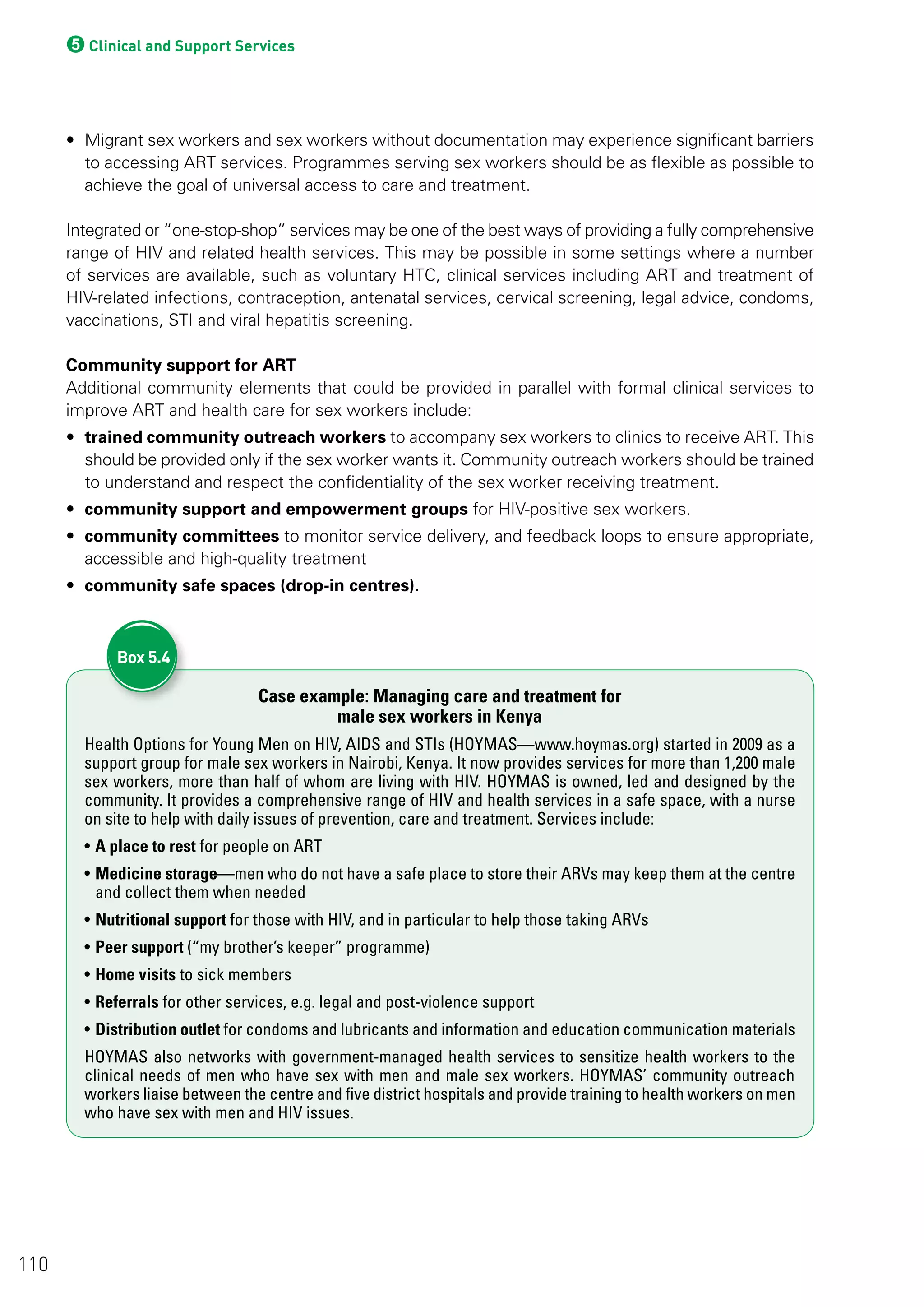
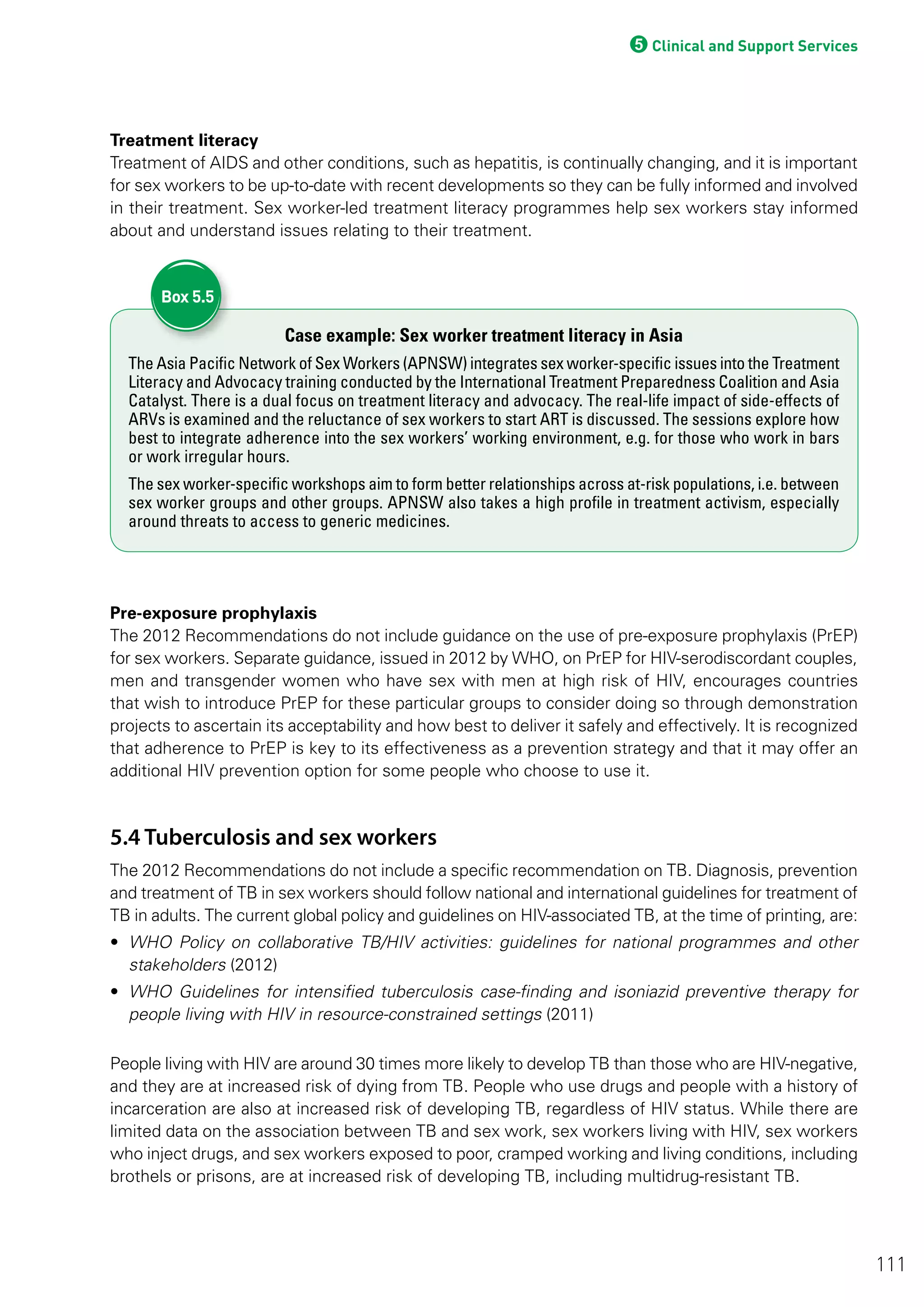

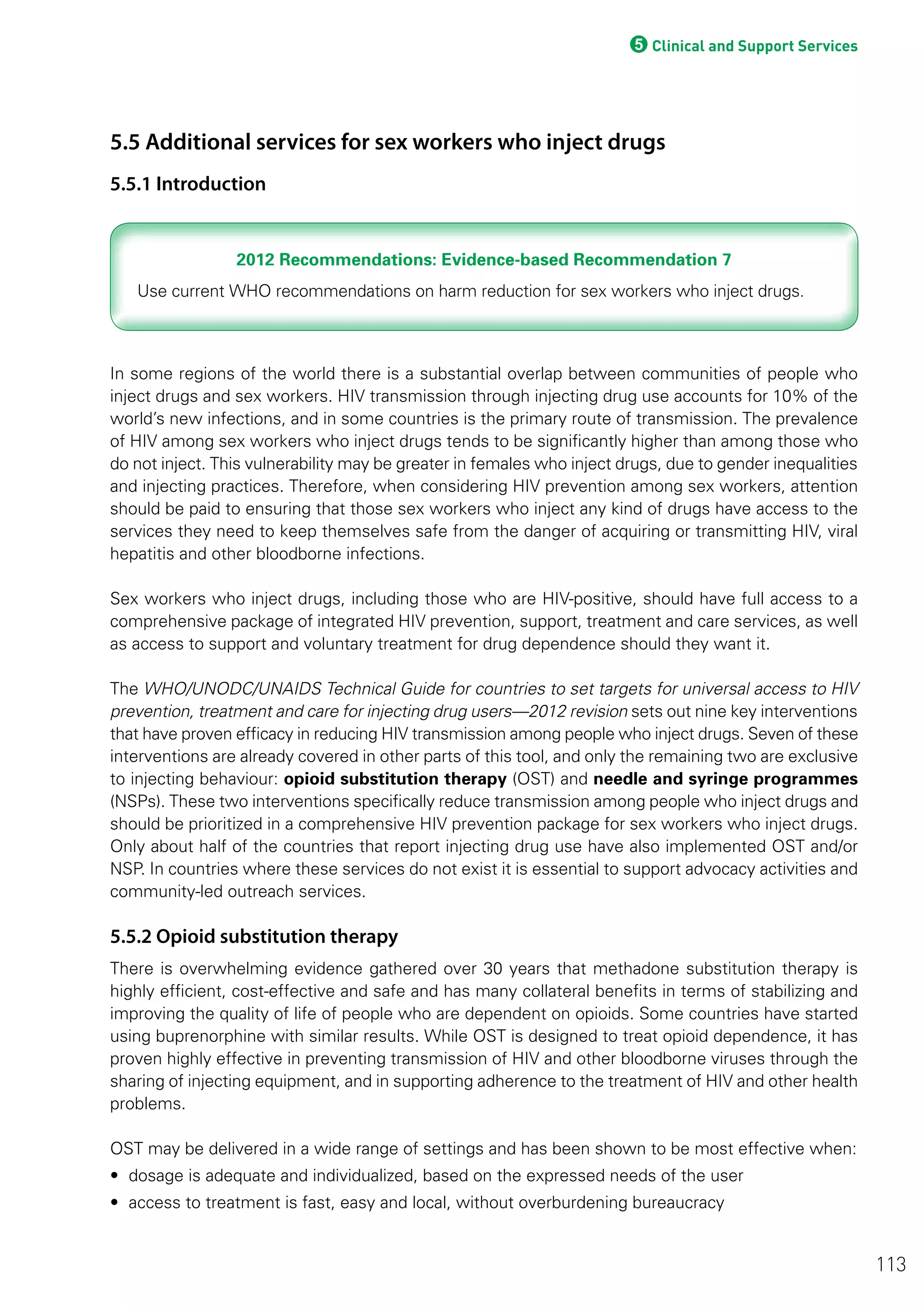

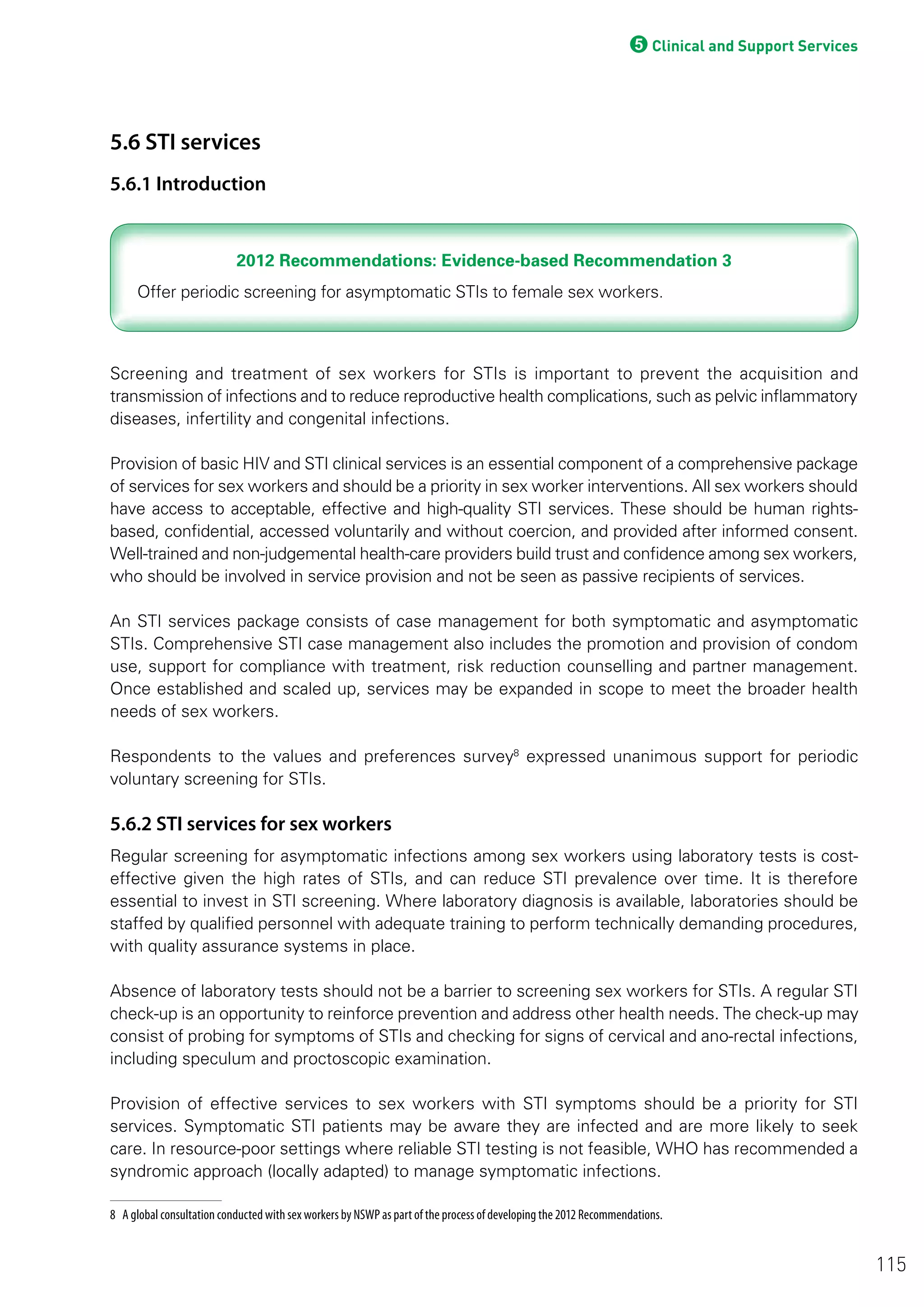
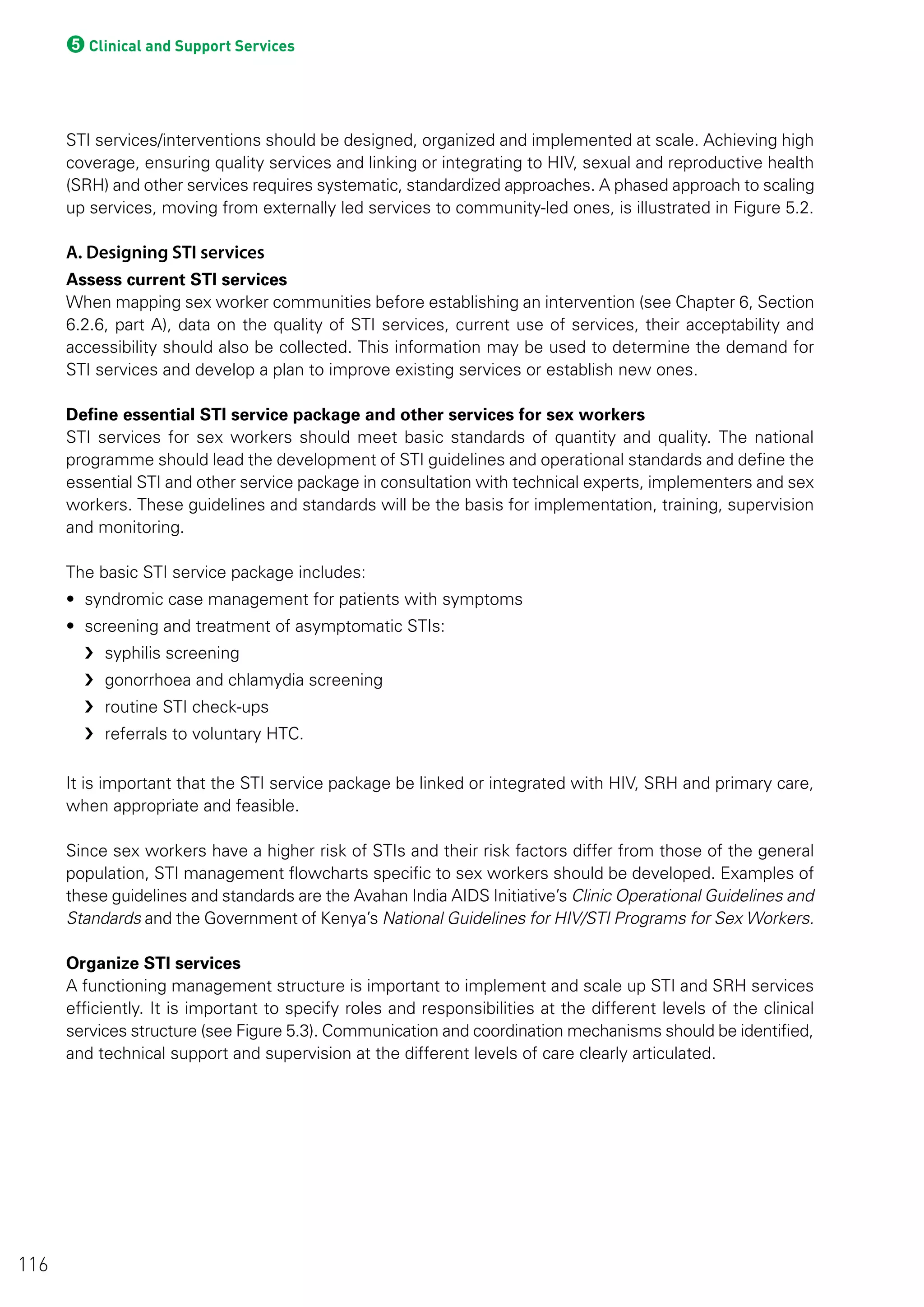





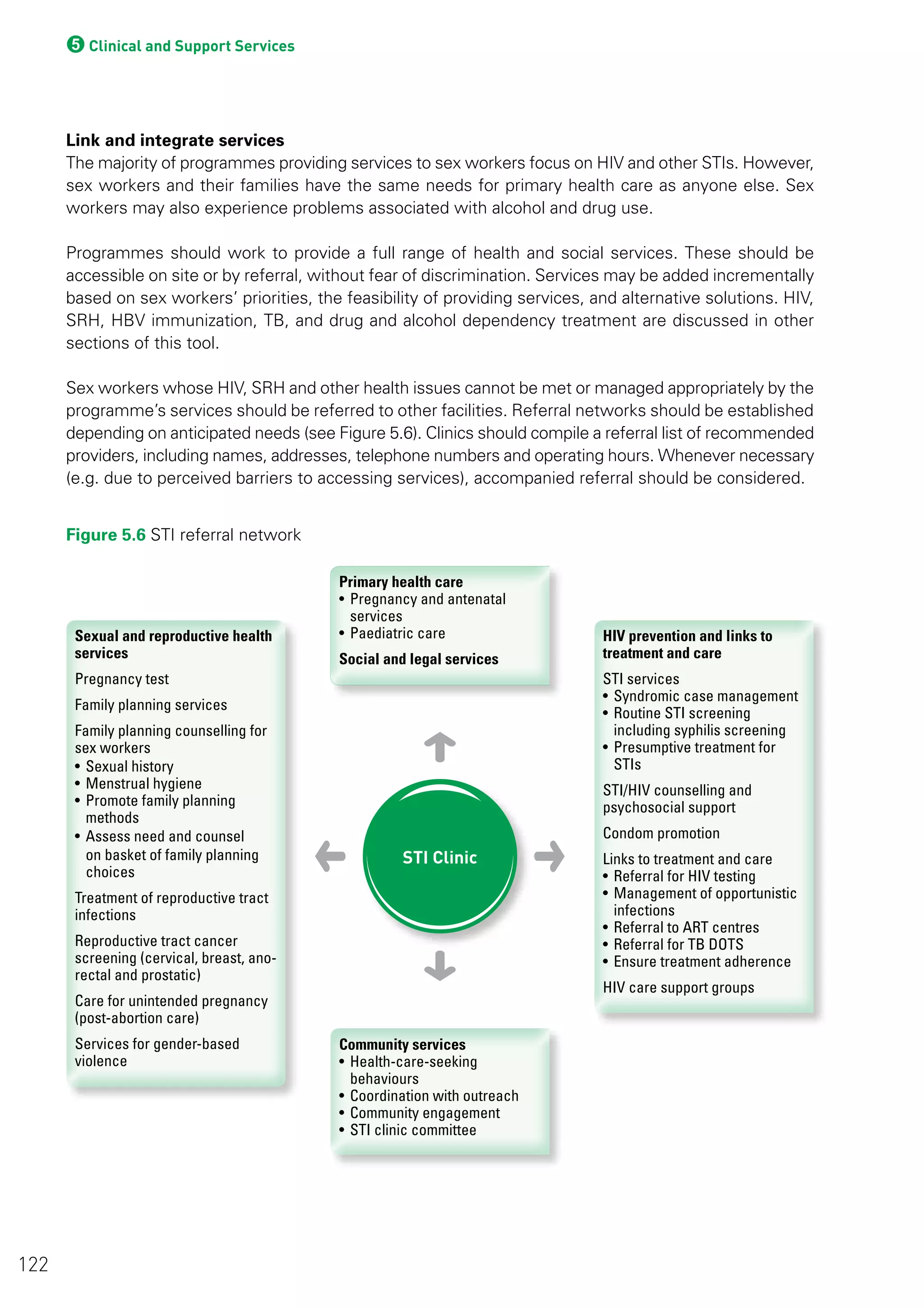

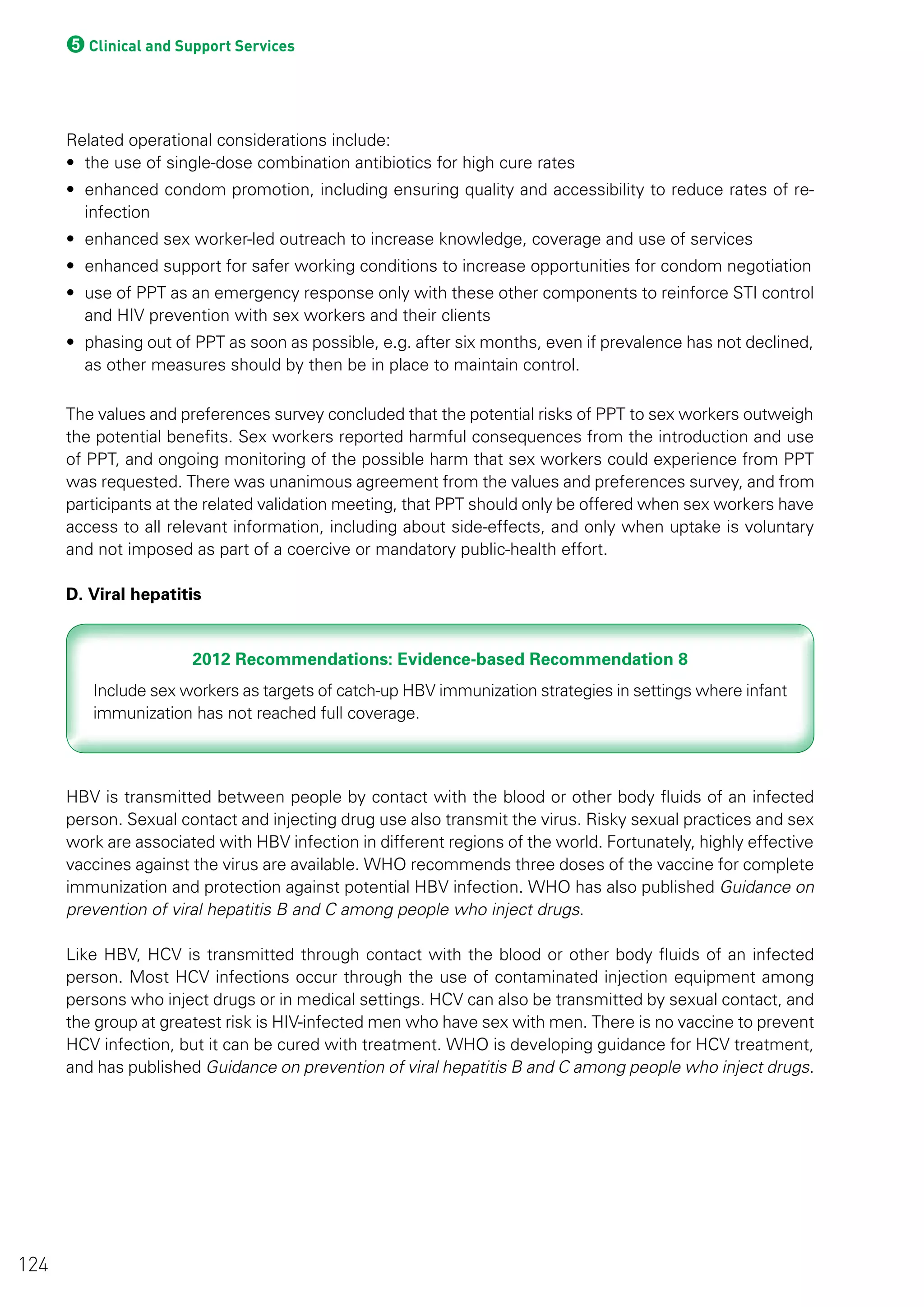




![5Clinical and Support Services
8. HIV Rapid Test Training Package. Geneva: World Health Organization [no date].
http://www.who.int/diagnostics_laboratory/documents/guidance/hivrttraining_overview/en/index.html
9. Laboratory Quality Management System Training Toolkit. Geneva: World Health Organization, 2011.
http://www.who.int/ihr/training/laboratory_quality/en/index.html
WHO guidance relevant to pre-exposure prophylaxis
1. Guidance on oral pre-exposure prophylaxis (PrEP) for serodiscordant couples, men and transgender women
who have sex with men at high risk of HIV: recommendations for use in the context of demonstration
projects. Geneva: World Health Organization, 2012.
http://www.who.int/hiv/pub/guidance_prep/en/
WHO guidance relevant to tuberculosis
1. WHO policy on collaborative TB/HIV activities: guidelines for national programmes and other stakeholders.
Geneva: World Health Organization, 2012.
http://www.who.int/tb/publications/2012/tb_hiv_policy_9789241503006/en/index.html
2. Guidelines for intensified tuberculosis case-finding and isoniazid preventive therapy for people living with HIV
in resource-constrained settings. Geneva: World Health Organization, 2011.
http://www.who.int/hiv/pub/tb/9789241500708/en/
3. Rapid implementation of the Xpert MTB/RIF diagnostic test: technical and operational “How-to”; practical
considerations. Geneva: World Health Organization, 2011.
http://whqlibdoc.who.int/publications/2011/9789241501569_eng.pdf
4. Global tuberculosis report 2013. Geneva: World Health Organization, 2013. In press.
WHO guidance relevant to injecting drug use
1. WHO/UNODC/UNAIDS Technical guide for countries to set targets for universal access to HIV prevention,
treatment and care for injecting drug users – 2012 revision. Geneva: World Health Organization, 2013.
http://www.who.int/hiv/pub/idu/targets_universal_access/en/index.html
2. Guidelines for the psychosocially assisted pharmacological treatment of opioid dependence. Geneva: World
Health Organization, 2009.
http://www.who.int/hiv/pub/idu/opioid/en/index.html
3. Guide to starting and managing needle and syringe programmes. Geneva: World Health organization, 2007.
http://www.who.int/hiv/pub/idu/needleprogram/en/index.html
4. The Alcohol, Smoking and Substance Involvement Screening Test (ASSIST): manual for use in primary care.
Geneva: World Health Organization, 2010.
http://www.who.int/substance_abuse/activities/assist/en/
5. The ASSIST-linked brief intervention for hazardous and harmful substance use: manual for use in primary care.
Geneva: World Health Organization, 2010.
http://whqlibdoc.who.int/publications/2010/9789241599399_eng.pdf
Guidance relevant to male medical circumcision
1. UN resources on male circumcision for HIV prevention. Geneva: World Health Organization and Joint United
Nations Programme on HIV/AIDS, 2010.
http://www.who.int/hiv/pub/malecircumcision/mc_un_inventory/en/index.html
Guidance relevant to sexually transmitted infections
1. Guidelines for the management of sexually transmitted infections. Geneva: World Health Organization, 2003.
http://www.who.int/reproductivehealth/publications/rtis/9241546263/en/index.html
2. Expert consultation and review of the latest evidence to update guidance for the management of sexually
transmitted infections: meeting report. Geneva: World Health Organization, 2011.
http://www.who.int/reproductivehealth/publications/rtis/rhr_11_37/en/index.html
129](https://image.slidesharecdn.com/9789241506182eng-140612092504-phpapp02/75/9789241506182-eng-151-2048.jpg)
![5Clinical and Support Services
3. Sexually transmitted and other reproductive tract infections: a guide to essential practice. Geneva: World
Health Organization, 2005.
http://www.who.int/reproductivehealth/publications/rtis/9241592656/en/index.html
4. The use of rapid syphilis tests. Geneva: World Health Organization/Special programme for Research and
Training in Tropical Diseases (TDR), 2006.
http://www.who.int/reproductivehealth/publications/rtis/TDR_SDI_06_1/en/index.html
5. Prevention and treatment of HIV and other sexually transmitted infections among men who have sex with
men and transgender people: recommendations for a public health approach 2011. Geneva: World Health
Organization, 2011.
http://www.who.int/hiv/pub/guidelines/msm_guidelines2011/en/index.html
6. Consolidated guidelines on the use of antiretroviral drugs for treating and preventing HIV infection:
recommendations for a public health approach. Geneva: World Health Organization, 2013.
http://www.who.int/hiv/pub/guidelines/arv2013/en/
7. A strategic approach to strengthening control of reproductive tract and sexually transmitted infections: use of
the programme guidance tool. Geneva: World Health Organization, 2009.
http://www.who.int/reproductivehealth/publications/rtis/9789241598569/en/index.html
8. Clinic Operational Guidelines & Standards: Comprehensive STI Services for Sex Workers in Avahan-Supported
Clinics in India. New Delhi: Family Health International [no date].
https://www.indiahiv.org/SitePages/PublicationType.aspx/2?keyid=18
9. National Guidelines for HIV/STI Programs for Sex Workers. Government of Kenya, Ministry of Public Health
and Sanitation, 2010.
http://nascop.or.ke/library/Marps/Sex%20Worker%20Guidelines.pdf
10. Position paper on hepatitis B. World Health Organization Weekly Epidemiological Record, 2009, 84:405–420.
http://www.who.int/wer/2009/wer8440.pdf
11. Guidance on prevention of viral hepatitis B and C among people who inject drugs. Geneva: World Health
Organization, 2012.
http://www.who.int/hiv/pub/guidelines/hepatitis/en/index.html
Sexual and reproductive health
1. Family Planning: A Global Handbook for Providers (2011 update). Baltimore, MD and Geneva: Johns Hopkins
Bloomberg School of Public Health/Center for Communication Programs and World Health Organization,
2011.
http://www.who.int/reproductivehealth/publications/family_planning/9780978856304/en/index.html
2. Safe abortion: technical and policy guidance for health systems—Second edition. Geneva: World Health
Organization, 2012.
http://www.who.int/reproductivehealth/publications/unsafe_abortion/9789241548434/en/index.html
3. WHO guidance note: comprehensive cervical cancer prevention and control – a healthier future for girls and
women. Geneva: World Health Organization, 2013.
http://www.who.int/reproductivehealth/publications/cancers/9789241505147/en/index.html
4. Responding to intimate partner violence and sexual violence against women: WHO clinical and policy
guidelines. Geneva: World Health Organization, 2013.
http://www.who.int/reproductivehealth/publications/violence/9789241548595/en/
Mental health
1. Risks to mental health: an overview of vulnerabilities and risk factors. Background paper by WHO secretariat
for the development of a comprehensive mental health action plan. Geneva: World Health Organization, 2012.
http://www.who.int/mental_health/mhgap/risks_to_mental_health_EN_27_08_12.pdf
2. mHGAP Intervention Guide for mental, neurological and substance use disorders in non-specialized health
settings. Geneva: World Health Organization, 2010.
http://www.who.int/mental_health/evidence/mhGAP_intervention_guide/en/
130](https://image.slidesharecdn.com/9789241506182eng-140612092504-phpapp02/75/9789241506182-eng-152-2048.jpg)















![6Programme Management and Organizational Capacity-building
Component Indicator Data sources
Establishing and maintaining programme infrastructure
Presence in
geographic
area
% of districts/counties with contracts
signed to establish services
Programme data/reports
Planning documents based on mapping
and size estimates
% of towns/locations with
comprehensive services established
Programme data/reports
Planning documents based on mapping
and size estimates
Services in
geographic
area
% of project offices established Programme data/reports
Planning documents based on mapping
and size estimates
% of safe spaces (drop-in centres)/
community centres established/open
Programme data/reports
Planning documents based on mapping
and size estimates
% of interventions with established links
to reproductive health services
Programme data/reports
Site assessment reports
% of interventions with established links
to voluntary HTC services
Programme data/reports
Site assessment reports
% of interventions with established links
to HIV care and treatment services
Programme data/reports
Site assessment reports
Project staff
hired and
trained
% of district/county director/coordinators Programme reports
Planning documents
% of outreach supervisors/managers
(target is 1 per 5–7 community outreach
workers)
Programme reports
Population size estimates
% of technical staff at district/county
level (target is to have enough to visit
all sites at least monthly for supportive
supervision/data review—usually 1
covers 3–5 sites). Illustrative technical
areas: monitoring for management,
clinical services (reproductive health,
voluntary HTC, antiretroviral therapy
[ART] care), structural interventions/
advocacy, outreach, management/
financial.
Programme reports
Planning documents
Table 6.3 Illustrative monitoring indicators for multi-component sex worker intervention
These are illustrative indicators; additional ones may be appropriate for each intervention area. Programme
planners should consult the WHO Technical guide for countries to programme, monitor and set targets for
HIV prevention, treatment and care for sex workers and men who have sex with men and transgender people
(under development by WHO) and other guidance in countries. Priority considerations are: useful indicators for
implementation that may also be aggregated upwards; and consistency in definitions across all implementing
partners in the country in order to get an overall picture of progress.
146](https://image.slidesharecdn.com/9789241506182eng-140612092504-phpapp02/75/9789241506182-eng-168-2048.jpg)

![6Programme Management and Organizational Capacity-building
Component Indicator Data sources
Clinical services
Reproductive
health/STI
service use
% individual sex workers referred for STI
services monthly
Referral forms
Periodic denominator estimates
% individual sex workers accessing STI
services monthly
Clinic forms
Periodic denominator estimates
STI syndromes % individual sex workers with STI
syndrome who visit clinic quarterly
Clinic forms
HIV testing and
counselling
% of sex workers referred to voluntary
HTC services monthly
Referral forms
Periodic denominator estimates
HIV care and
treatment
% of sex workers newly diagnosed with
HIV referred to care services monthly
Programme forms
% of sex workers eligible for ART who
are started on ART monthly
Programme forms
% of sex workers started on ART who
remain in care and are adherent to
regimens at one year
Clinic forms
Structural interventions/Community mobilization
Rights
violations
Number of reported incidents of violence
against individual sex workers
Violence report forms
% of reports of violence responded to
within [designated time period] by crisis
response system
Crisis response forms
Stigma Number of reported incidents of stigma
in clinical services
Stigma report forms
Social
entitlements
Number of sex workers accessing ration
cards/voting cards/ID/bank accounts,
etc.
Report forms
Community
mobilization
% of community group members who are
sex workers but not community outreach
workers
Report forms
148](https://image.slidesharecdn.com/9789241506182eng-140612092504-phpapp02/75/9789241506182-eng-170-2048.jpg)


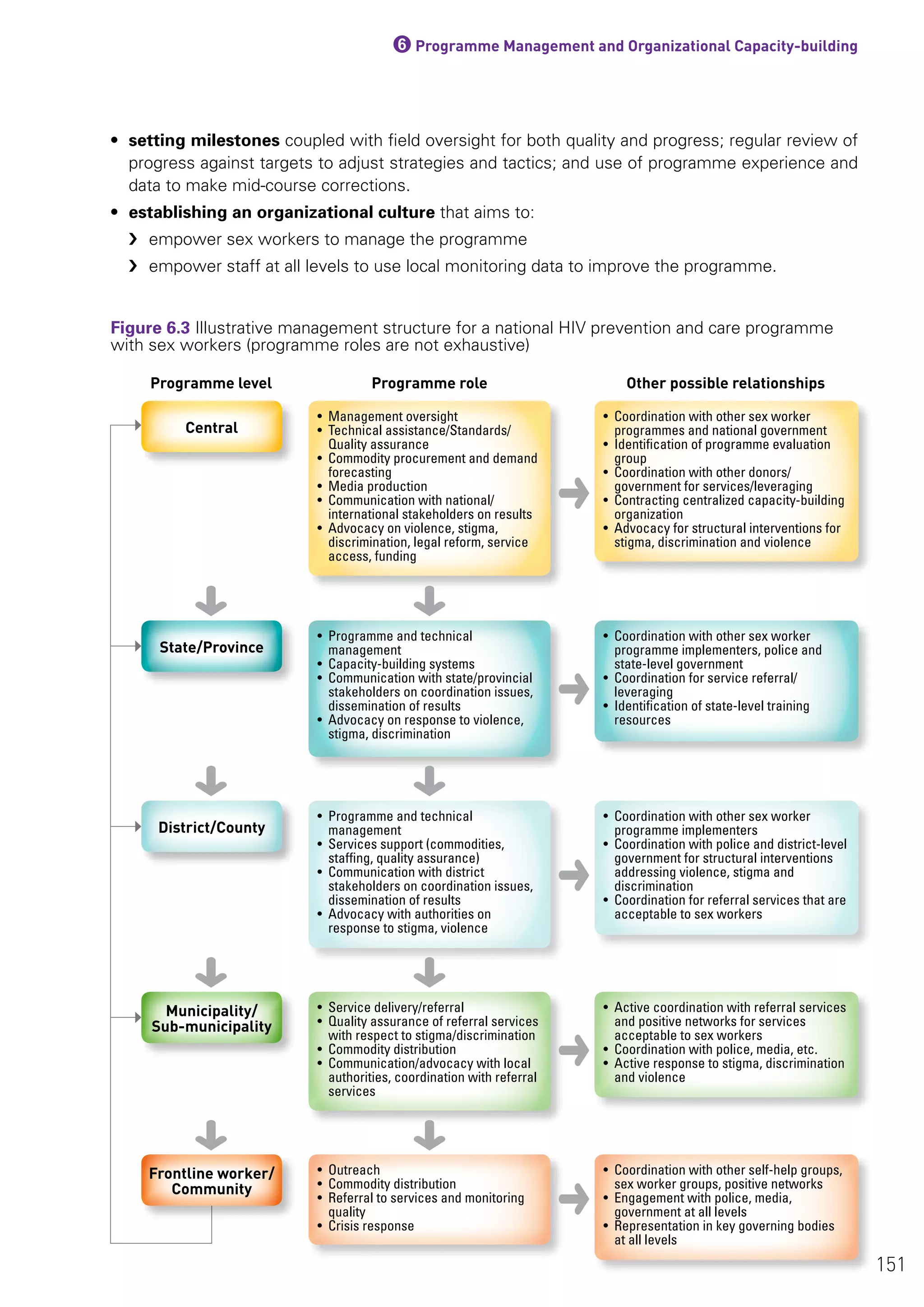






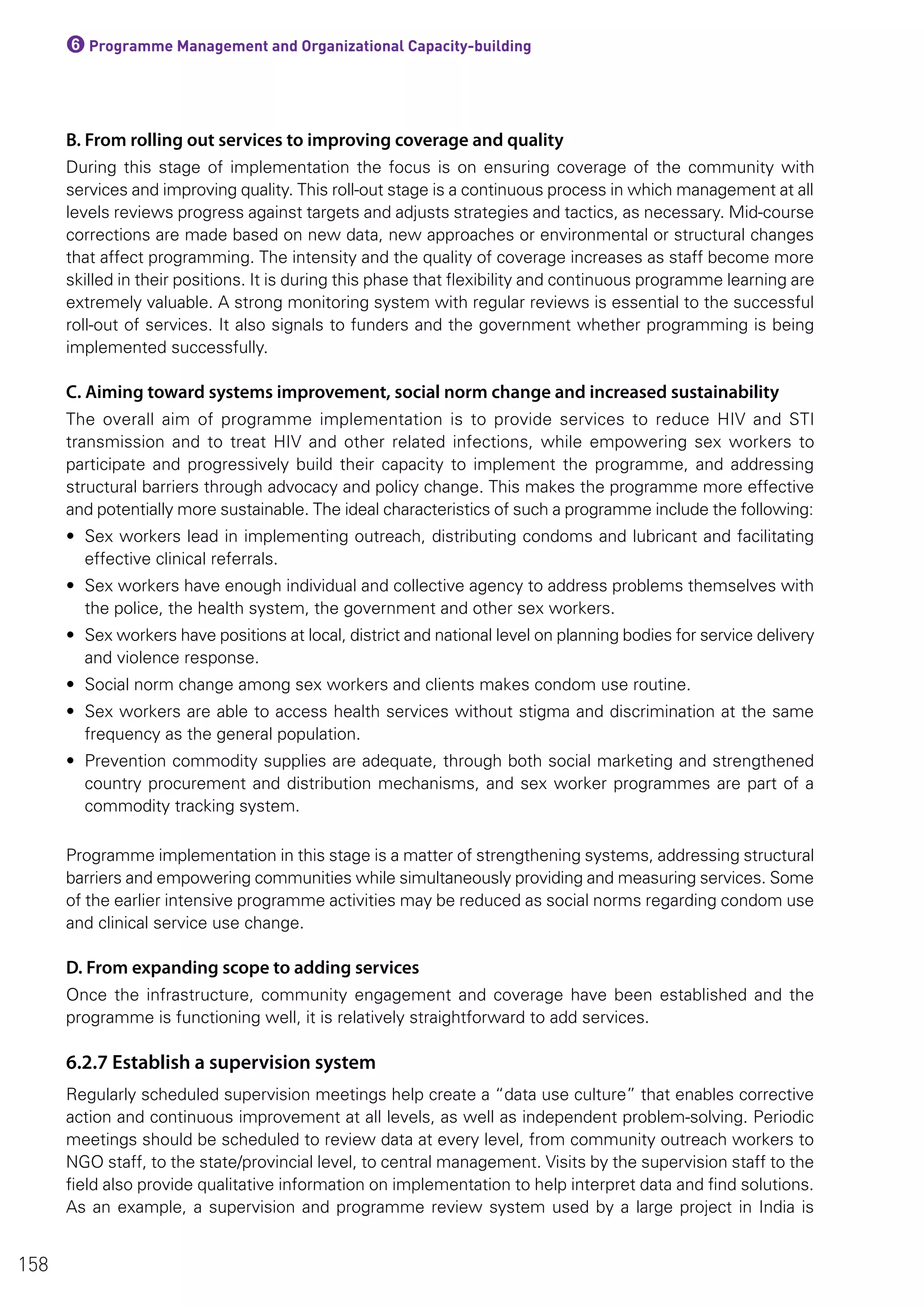










![6Programme Management and Organizational Capacity-building
8. National Guidelines for Implementation of HIV Prevention Programs for Female Sex Workers in Nigeria.
National AIDS Control Agency, Government of Nigeria, 2013.
http://naca.gov.ng/index2.php?option=com_docman&task=doc_view&gid=152&Itemid=268
Defining programme logic model, implementation components and standards
1. Prevention and treatment of HIV and other sexually transmitted infections for sex workers in low- and middle-
income countries: recommendations for a public health approach. Geneva: WHO, UNFPA, UNAIDS, NSWP,
2012.
http://apps.who.int/iris/bitstream/10665/77745/1/9789241504744_eng.pdf
2. A Systematic Approach to the Design and Scale-up of Targeted Interventions for HIV Prevention among Urban
Female Sex Workers. Bangalore, India: Karnataka Health Promotion Trust, University of Manitoba, World
Bank, 2012.
http://www.khpt.org/reports%20pdf/A%20Systematic%20Approach%20to%20the%20Design%20and%20
Scale-Up%20of%20Targeted%20Interventions%20for%20HIV%20Prevention,%20full%20version.pdf
3. UNAIDS guidance note on HIV and sex work. Geneva: Joint United Nations Programme on HIV/AIDS, 2012.
http://www.unaids.org/en/media/unaids/contentassets/documents/unaidspublication/2009/JC2306_UNAIDS-
guidance-note-HIV-sex-work_en.pdf
4. Guidelines on estimating the size of populations most at risk to HIV. Geneva: UNAIDS/WHO Working Group
on Global HIV/AIDS and STI Surveillance, 2010.
http://www.unaids.org/en/media/unaids/contentassets/documents/epidemiology/2011/2011_estimating_
populations_en.pdf
5. PLACE—Priorities for Local AIDS Control Efforts: A Manual for Implementing the PLACE Method. Chapel Hill,
NC: MEASURE Evaluation, 2005.
http://www.cpc.unc.edu/measure/publications/ms-05-13
6. Clinic Operational Guidelines & Standards: Comprehensive STI Services for Sex workers in Avahan-Supported
Clinics in India. New Delhi: Family Health International [no date].
https://www.indiahiv.org/SitePages/PublicationType.aspx/2?keyid=18
7. Using Logic Models to Bring Together Planning, Evaluation, and Action: Logic Model Development Guide.
Battle Creek, MI: W.K. Kellogg Foundation, 2004.
http://www.wkkf.org/knowledge-center/resources/2006/02/wk-kellogg-foundation-logic-model-development-
guide.aspx
Routine programme monitoring system
1. Technical Guide for Countries to Programme, Monitor and Set Targets for HIV Prevention, Treatment and Care
for Sex Workers, Men who Have Sex with Men and Transgender People. Geneva: World Health Organization,
2013. In press.
http://www.who.int/hiv/pub/guidelines/targets_key_populations/
2. Operational Guidelines for Monitoring and Evaluation of HIV Programmes for Sex Workers, Men who have
Sex with Men, and Transgender People. Volume 1: National and Sub-National Levels. Chapel Hill, NC:
MEASURE Evaluation, 2013.
http://www.cpc.unc.edu/measure/publications/ms-11-49a
3. Toolkit for monitoring and evaluation of interventions for sex workers. World Health Organization South-East
Asia and Western Pacific Regions, 2009.
http://www.aidsdatahub.org/dmdocuments/ToolKit_M_E_SW.pdf
4. National AIDS Programmes: A Guide to Monitoring and Evaluation. Geneva: Joint United Nations Programme
on HIV/AIDS, 2000.
https://www.unaids.org/en/media/unaids/contentassets/dataimport/publications/irc-pub05/jc427-mon_ev-
full_en.pdf
5. A Guide to Monitoring and Evaluation of Capacity-Building Interventions in the Health Sector in Developing
Countries. MEASURE Evaluation Manual Series, No.7. Chapel Hill, NC: Carolina Population Center, University
of North Carolina at Chapel Hill, 2003.
http://www.aidstar-two.org/Tools-Database.cfm?action=detail&id=86&language_id=
6. Monitoring and Evaluation Systems Strengthening Tool. Developed by the Global Fund, PEPFAR, USAID, and
others. Published through the USAID Measaure Evaluation Project, 2007.
http://www.cpc.unc.edu/measure/publications/ms-07-18
169](https://image.slidesharecdn.com/9789241506182eng-140612092504-phpapp02/75/9789241506182-eng-191-2048.jpg)
![6Programme Management and Organizational Capacity-building
Supervision system
1. STI Clinic Supervisory Handbook, Comprehensive STI services for Sex Workers in Avahan-Supported Clinics in
India. New Delhi: Family Health International [no date].
http://www.aidsdatahub.org/dmdocuments/STI_Clinic_Supervisory_Handbook.pdf.pdf
2. Making Supervision Supportive and Sustainable: New Approaches to Old Problems. Washington, DC:
Maximizing Access and Quality Initiative, 2002.
http://www.k4health.org/sites/default/files/maqpaperonsupervision.pdf
3. Supportive Supervision to Improve Integrated Primary Health Care. Cambridge, MA: Management Sciences
for Health, 2006.
http://www1.msh.org/Documents/OccasionalPapers/upload/Supportive-Supervision-to-Improve-Primary-
Health-Care.pdf
Evaluation
1. Operational Guidelines for Monitoring and Evaluation of HIV Programmes for Sex Workers, Men who have
Sex with Men, and Transgender People. Measure Evaluation, North Carolina, 2013.
a. Volume I: National and Sub-National Levels.
http://www.cpc.unc.edu/measure/publications/ms-11-49a
b. Volume II: Service Delivery Providers. In press.
2. Behavioral Surveillance Surveys: Guidelines for Repeated Behavioral Surveys in Populations at Risk of HIV.
Arlington, VA: Family Health International, 2000.
http://www.who.int/hiv/strategic/en/bss_fhi2000.pdf
3. Guidelines on surveillance among populations most at risk for HIV. Geneva: UNAIDS/WHO Working Group on
Global HIV/AIDS and STI Surveillance, 2011.
http://www.unaids.org/en/media/unaids/contentassets/documents/epidemiology/2011/20110518_
Surveillance_among_most_at_risk.pdf
Organizational capacity-building
1. Community Mobilization of Female Sex Workers. Module 2: A Strategic Approach to Empower Female Sex
Workers in Karnataka. Bangalore, India: Karnataka Health Promotion Trust, 2008.
http://www.khpt.org/Community_Mobilization.pdf
2. Managers Who Lead: A Handbook for Improving Health Services. Cambridge, MA: Management Sciences for
Health, 2005.
http://www.msh.org/sites/msh.org/files/mwl-2008-edition.pdf
3. Health Systems in Action: An eHandbook for Leaders and Managers. Cambridge, MA: Management Sciences
for Health, 2010.
http://www.msh.org/resources/health-systems-in-action-an-ehandbook-for-leaders-and-managers
4. Systematic Organizational Capacity Building: Tackling Planning and Implementation Challenges. Cambridge,
MA: Management Sciences for Health, 2011.
www.aidstar-two.org/upload/AS2_Tech-Brief3.pdf
5. Organizational Capacity Building Framework: A Foundation for Stronger, More Sustainable HIV/AIDS
Programs, Organizations & Networks. Cambridge, MA: Management Sciences for Health, 2011.
www.aidstar-two.org/upload/AS2_TechnicalBrief-2_4-Jan-2011.pdf
6. Challenges Encountered in Capacity Building: A Review of Literature and Selected Tools. Cambridge, MA:
Management Sciences for Health, 2010.
www.aidstar-two.org/Focus-Areas/upload/AS2_TechnicalBrief_1.pdf
170](https://image.slidesharecdn.com/9789241506182eng-140612092504-phpapp02/75/9789241506182-eng-192-2048.jpg)



